Powerstroke PS171433 User Manual

OPERATOR’S MANUAL
MANUEL D’UTILISATION
MANUAL DEL OPERADOR
1700 PSI ELECTRIC PRESSURE WASHER
NETTOYEUR PRESSION À ÉLECTRIQUE DE 1700 PSI LAVADORA DE PRESIÓN A ELÉCTRICA DE 1700 PSI
PS171433
(ALL VERSIONS / TOUTES LES VERSIONS / TODAS LAS VERSIONES)
CUSTOMER SERVICE
SERVICE CLIENTELE
SERVICIO AL CLIENTE
USA: 1-877-617-3501
Mexico: 01 800 843 1111 www.powerstroketools.com
DO NOT USE E15 OR E85 FUEL IN THIS UNIT.
IT IS A VIOLATION OF FEDERAL LAW
AND WILL DAMAGE THE UNIT AND VOID YOUR WARRANTY.
NE PAS UTILISER D’ESSENCE E15 OU E85 DANS CET APPAREIL. UNE TELLE UTILISATION REPRÉSENTE UNE VIOLATION DE LA LOI FÉDÉRALE ET ENDOMMAGERA L’APPAREIL ET ANNULERA LA GARANTIE.
NO UTILICE COMBUSTIBLES E15 O E85 EN ESTA UNIDAD.
ESTO CONSTITUYE UNA VIOLACIÓN A LA LEY FEDERAL,
DAÑARÁ LA UNIDAD Y ANULARÁ LA GARANTÍA.
To register your POWERSTROKE product, please visit: http://register.powerstroketools.com/
Pour enregistrer votre produit de POWERSTROKE, s’il vous plaît la visite: http://register.powerstroketools.com/
Para registrar su producto de POWERSTROKE, por favor visita: http://register.powerstroketools.com/
Your pressure washer has been engineered and manufactured to our high standard for dependability, ease of operation, and operator safety. When properly cared for, it will give you years of rugged, trouble-free performance.
 WARNING: To reduce the risk of injury, the user must read and understand the operator’s manual before using this product.
WARNING: To reduce the risk of injury, the user must read and understand the operator’s manual before using this product.
Thank you for your purchase.
SAVE THIS MANUAL FOR FUTURE REFERENCE
Cenettoyeurhautepressionaétéconçuetfabriquéconformément aux strictes normes de fiabilité, simplicité d’emploi et sécurité d’utilisation. Correctement entretenu, il vous donnera des années de fonctionnement robuste et sans problème.
 AVERTISSEMENT : Pour réduire les risques de blessures, l’utilisateur doit lire et veiller à bien comprendre le manuel d’utilisation avant d’utiliser ce produit.
AVERTISSEMENT : Pour réduire les risques de blessures, l’utilisateur doit lire et veiller à bien comprendre le manuel d’utilisation avant d’utiliser ce produit.
Merci de votre achat.
Su lavadora de presión ha sido diseñada y fabricada de conformidad con las estrictas normas para brindar fiabilidad, facilidad de uso y seguridad para el operador. Con el debido cuidado, le brindará muchos años de sólido y eficiente funcionamiento.
 ADVERTENCIA:Para reducir el riesgo de lesiones, el usuario debe leer y comprender el manual del operador antes de usar este producto.
ADVERTENCIA:Para reducir el riesgo de lesiones, el usuario debe leer y comprender el manual del operador antes de usar este producto.
Le agradecemos su compra.
CONSERVER CE MANUEL POUR |
|
GUARDE ESTE MANUAL PARA |
FUTURE RÉFÉRENCE |
|
FUTURAS CONSULTAS |
|
|
|
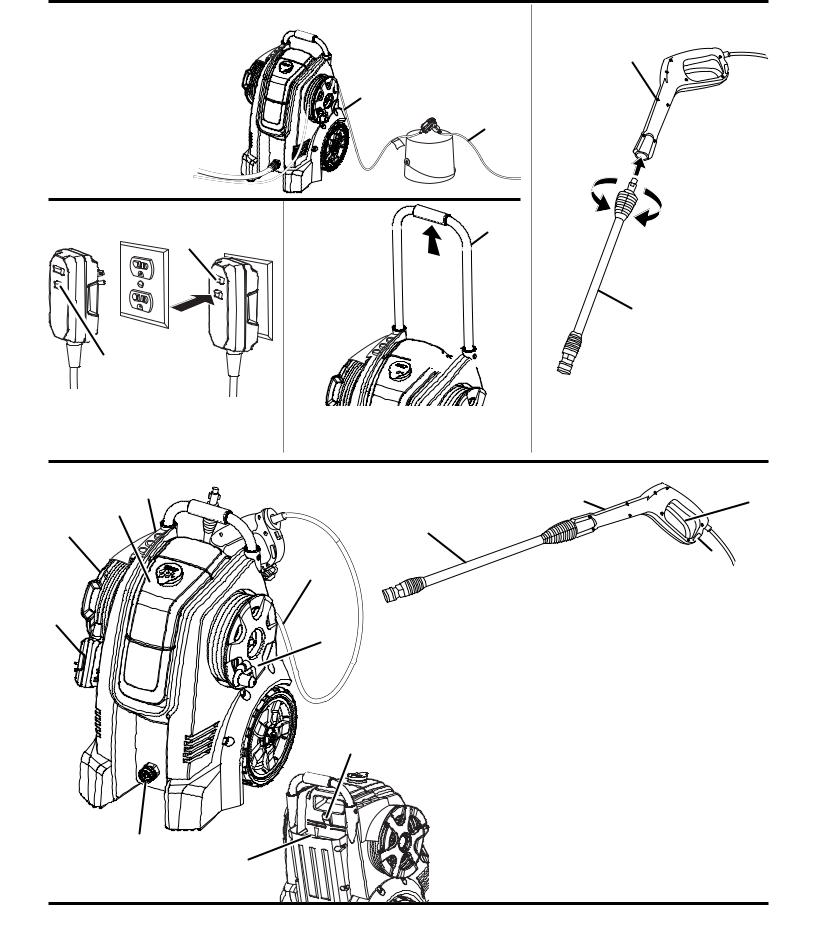
See this fold-out section for all of the figures referenced in the operator’s manual.
Consulter l’encart à volets afin d’examiner toutes les figures mentionnées dans le manuel d’utilisation. Consulte esta sección desplegable para ver todas las figuras a las que se hace referencia en el manual del operador.
Fig. 1
A - Pressure washer power cord (cordon d’alimentation de la laveuse à pression, cordón de corriente de la lavadora de presión)
B - Drip loop (boucle d’égouttement, vuelta de goteo)
C - Extension cord (cordon prolongateurs, cordón de extensión)
A
C
B
Fig. 2
B
A
A - Test button (essayer le bouton, botón de prueba)
B - Reset button (bouton « reset », botón de reajuste)
Fig. 4
A
B















 B
B
A - Handle assembly (ensemble de poignée, conjunto de mango)
B - Buttons (boutons, botóns)
Fig. 5
A
B
A - Trigger handle (poignée à gâchette, mango del gatillo)
B - Spray wand (poignée à gâchette, tubo rociador)
Fig. 3
L |
M |
C |
|
H |
|||
|
|
||
K |
B |
|
|
|
D |
|
|
E |
|
|
|
A |
A - Electrical cord with GFCI plug (cordon électrique avec prises |
||
GFCI, cordón del mango con tomacorriente GFCI) |
|
||
|
|
||
J |
B - Spray wand (lance de pulvérisation, tubo rociador) |
|
|
C - Trigger (gâchette, gatillo) |
|
||
|
|
||
|
D - Lock-out button (bouton de verrouillage, botón del seguro) |
|
|
|
E - High pressure hose (tuyau haute pression, manguera de alta |
||
|
presión) |
|
|
|
F - Water intake (prise d’eau, entrada de agua) |
|
|
|
G - On/off switch (interrupteur marche/arrêt, interruptor de |
||
|
encendido/apagado) |
|
|
G |
H - Detergent tank (réservoir de détergent, tanque de detergente) |
||
|
I - Spray wand holder (zone de rangement de la lance de |
||
|
pulvérisation, almacenamiento del tubo rociador) |
|
|
|
J - High pressure hose storage reel (dévidoir pour tuyau haute |
||
|
pression, carrete de almacenamiento de la manguera de alta |
||
|
presión) |
|
|
|
K - Face of power cord storage reel (couvercle du dévidoir pour |
||
F |
cordon d’alimentation, frente del carrete de almacenamiento del |
||
cordón eléctrico) |
|
||
I |
|
||
L - Nozzle storage (rangement de buse, almacenamiento de |
|||
|
boquillas) |
|
|
|
M- Trigger handle (poignée de gâchete, mango del gatillo) |
|
|
ii
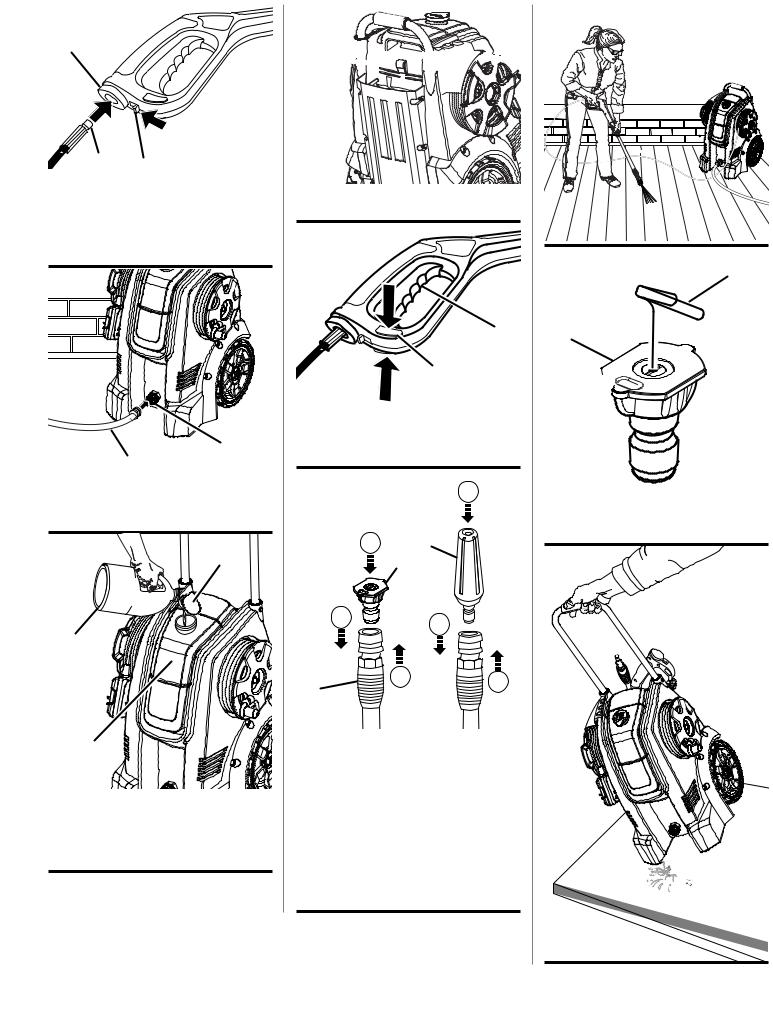
Fig. 6
A
B C
A - Hose inlet (arrivée de tuyau, entrada de manguera)
B - High pressure hose (tuyau de haute pression, manguera de alt a presión)
C - Hose lock (verrouillage de tuyau, bloqueo de manguera)
Fig. 7
B
A
A - Garden hose (tuyau d’arrosage, manguera de jardín)
B - Water intake (rise d’eau, entrada de agua)
Fig. 8 |
A |
|
B
C
A - Cap (capuchon, tapa)  B - Detergent (détergente, detergente)
B - Detergent (détergente, detergente)
C - Detergent tank (réservoir de détergente, tanque de detergente)
Fig. 9
A 









A - On/off switch (interrupteur marche/arrêt, interruptor de encendido)
Fig. 10
A
B
A - Trigger (gâchette, gatillo)
B - Lock-out button (bouton de verrouillage, botón de seguro)
Fig. 11 |
|
E |
|
|
|
E |
B |
C |
|
|
|
25 |
|
|
D |
|
D |
|
|
|
A |
F |
F |
|
||
|
|
A - Spray wand (lance de pulvérisation, tubo rociador)
B - Nozzle (buse, boquilla)
C - Turbo nozzle (buse de turbo, boquilla de turbo)
D - Pull back the quick-connect collar (tirer la bague à connexion rapide, tire del collar de conexión rápida)
E- Push the nozzle into place (insérer en place la buse, introduzca la boquilla en su lugar)
F- Push the collar forward (poussez en avant la
bague, empuje del collar adelante)
Fig. 12
Fig. 13 |
A |
|
B

 25
25 
A - Straightened paper clip (trombone droit, clip para papel abierto)
B - Nozzle (embout, boquilla)
Fig. 14
iii
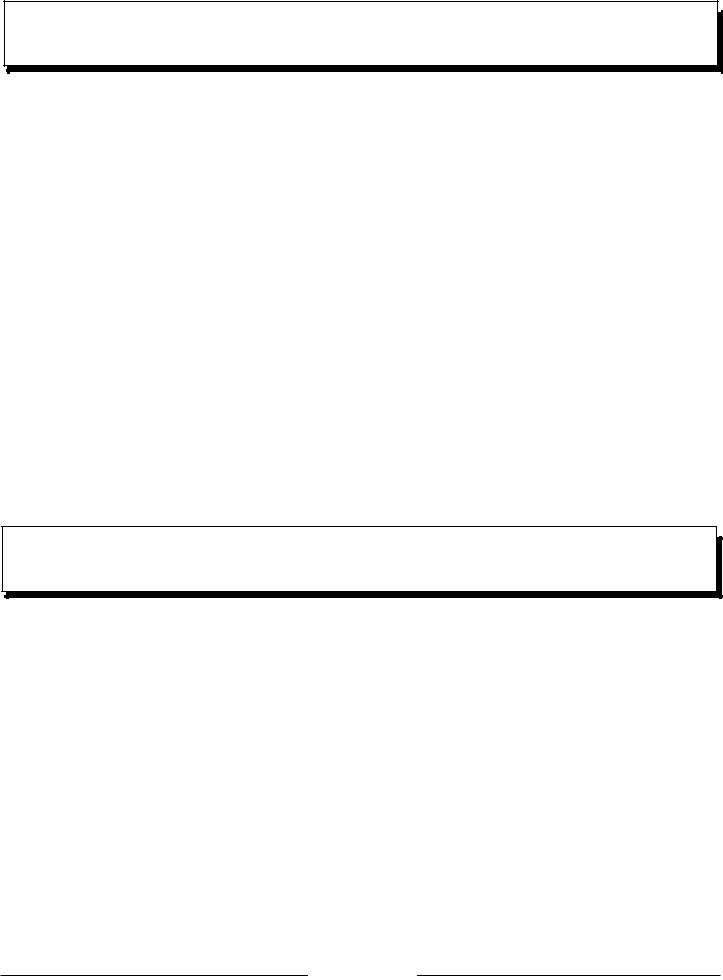
TABLE OF CONTENTS
TABLE DES MATIÈRES / ÍNDICE DE CONTENIDO
Introduction....................................................................................................................................................................... |
2 |
Introduction / Introducción |
|
Important Safety Instructions............................................................................................................................................ |
3 |
Instructions importantes concernant la sécurité / Instrucciones importantes de seguridad |
|
Specific Safety Rules..................................................................................................................................................... |
4-5 |
Règles de sécurité particulières / Reglas de seguridad específicas |
|
Symbols......................................................................................................................................................................... |
6-7 |
Symboles / Símbolos |
|
Electrical............................................................................................................................................................................ |
8 |
Caractéristiques électriques / Aspectos eléctricos |
|
Features............................................................................................................................................................................ |
9 |
Caractéristiques / Características |
|
Assembly...................................................................................................................................................................... |
9-10 |
Assemblage / Armado |
|
Operation................................................................................................................................................................... |
11-13 |
Utilisation / Funcionamiento |
|
Maintenance.................................................................................................................................................................... |
13 |
Entretien / Mantenimiento |
|
Troubleshooting............................................................................................................................................................... |
14 |
Dépannage / Solución de problemas |
|
Warranty.......................................................................................................................................................................... |
15 |
Garantie / Garantía |
|
Parts Ordering and Service................................................................................................................................ |
Back Page |
Commande de pièces et réparation / Pedidos de piezas y servicio.......................................................... |
Page arrière / Pág. posterior |
INTRODUCTION
INTRODUCTION / INTRODUCCIÓN
This product has many features for making its use more pleasant and enjoyable. Safety, performance, and dependability have been given top priority in the design of this product making it easy to maintain and operate.
* * *
Ce produit offre de nombreuses fonctions destinées à rendre son utilisation plus plaisante et satisfaisante. Lors de la conception de ce produit, l’accent a été mis sur la sécurité, les performances et la fiabilité, afin d’en faire un outil facile à utiliser et à entretenir.
* * *
Este producto ofrece numerosas características para hacer más agradable y placentero su uso. En el diseño de este producto se ha conferido prioridad a la seguridad, el desempeño y la fiabilidad, por lo cual se facilita su manejo y mantenimiento.
Page / Página 2
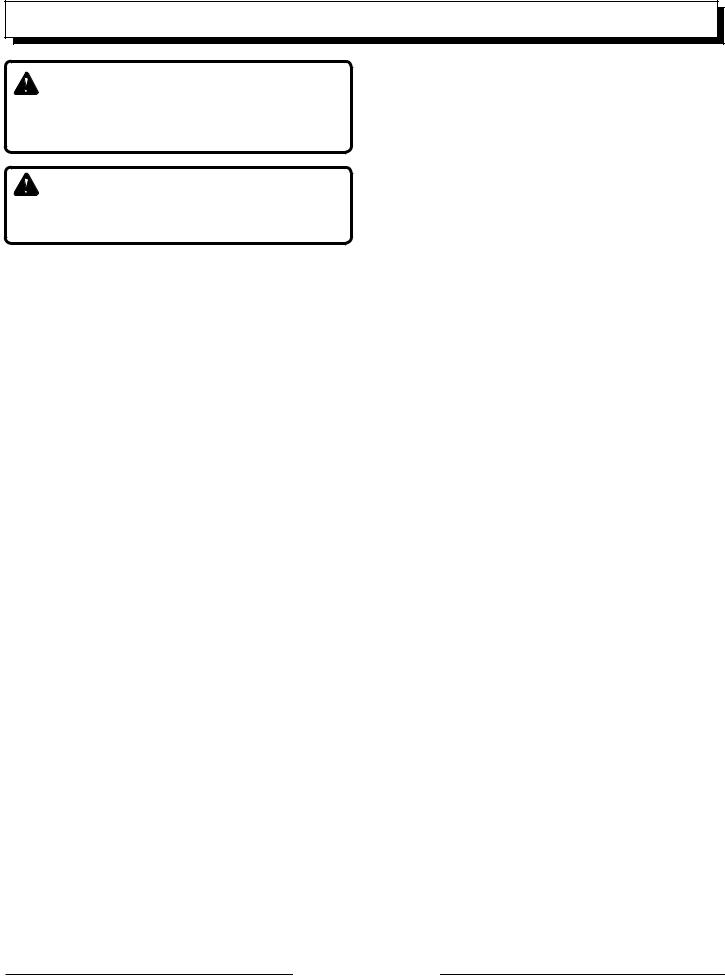
IMPORTANT SAFETY INSTRUCTIONS
WARNING:
Read and understand all instructions. Failure to follow all instructions listed below may result in electric shock, fire, and/or serious personal injury.
WARNING:
When using this product basic precautions should always be followed, including the following:
READ ALL INSTRUCTIONS BEFORE USING THIS PRODUCT
To reduce the risk of injury, close supervision is necessary when a product is used near children.
Be thoroughly familiar with controls. Know how to stop the product and release pressure quickly.
Stay alert and exercise control. Watch what you are doing and use common sense. Do not operate product when you are tired. Do not rush.
Do not operate the product while under the influence of drugs, alcohol, or any medication.
Keep the area of operation clear of all persons, particularly small children, and pets.
Don’t overreach or stand on unstable support. Keep proper footing and balance at all times.
Follow the maintenance instructions specified in this manual.
This product is provided with a ground fault circuit interrupter built into the power cord plug. If replacement of the plug or cord is needed, use only identical replacement parts.
WARNING: Risk of injection or injury – Do not direct discharge stream at persons.
SAVE THESE INSTRUCTIONS
GROUND FAULT CIRCUIT INTERRUPTER PROTECTION
This pressure washer is provided with a ground fault circuit interrupter (GFCI) built into the plug of the power supply cord. This device provides additional protection from the risk of electric shock. Should replacement of the plug or cord become necessary, use only identical replacement parts that include GFCI protection.
EXTENSION CORDS
See Figure 1.
Use only extension cords that are intended for outdoor use. These extension cords are identified by a marking “Acceptable for use with outdoor appliances; store indoors while not in use.” Use only extension cords having an electrical rating not less than the rating of the product. Do not use damaged extension cords. Examine extension cord before using and replace if damaged. Do not abuse extension cord and do
not yank on any cord to disconnect. Keep cord away from heat and sharp edges. Always disconnect the extension cord from the receptacle before disconnecting the product from the extension cord. Always plug the extension cord into a GFCI protected outlet.
To avoid the possibility of the tool plug getting wet when using an extension cord, arrange a “drip loop” in the cord connecting the pressure washer to the extension cord. The “drip loop” is that part of the cord below the level of the connector which prevents water travelling along the cord and coming in contact with the connection. If the plug does get wet, DO NOT unplug the cord. Disconnect the fuse or circuit breaker that supplies power to the tool, then unplug and examine for presence of water in the connection.
WARNING: To reduce the risk of electrocution, keep all connections dry and off the ground. Do not touch plug with wet hands.
Page 3 — English

SPECIFIC SAFETY RULES
To reduce the risk of electric shock the supervisory circuit must be operated before an appliance is plugged into any receptacle on the device.
Knowyourproduct.Read the operator’s manual carefully. Learn the machine’s applications and limitations as well as the specific potential hazards related to this product.
To reduce the risk of injury, keep children and visitors away. All visitors should wear safety glasses and be kept a safe distance from work area.
Use right product. Don’t force product or attachment to do a job it was not designed for. Don’t use it for a purpose not intended.
Dress properly. Do not wear loose clothing, gloves, neckties, or jewelry. They can get caught and draw you into moving parts. Rubber gloves and nonskid footwear are recommended when working outdoors. Also wear protective hair covering to contain long hair.
Do not operate the equipment while barefoot or when wearing sandals or similar lightweight footwear. Wear protective footwear that will protect your feet and improve your footing on slippery surfaces.
Exercise caution to avoid slipping or falling.
Alwayswear eye protection with side shields marked to comply with ANSI Z87.1. Following this rule will reduce the risk of serious personal injury.
Use only recommended accessories. The use of improper accessories may cause risk of injury.
Check damaged parts. Before further use of the product, a guard or other part that is damaged should be carefully checked to determine that it will operate properly and perform its intended function. Check for alignment of moving parts, binding of moving parts, breakage of parts, mounting, and any other conditions that may affect its operation. A guard or other part that is damaged must be properly repaired or replaced by an authorized service center to avoid risk of personal injury.
Never leave product running unattended. Turn power off. Don’t leave product until it comes to a complete stop.
Keep the motor free of grass, leaves, or grease to reduce the chance of a fire hazard.
Follow manufacturer’s recommendations for safe loading, unloading, transport, and storage of machine.
Keep product dry, clean, and free from oil and grease.
Always use a clean cloth when cleaning. Never use brake fluids, gasoline, petroleum-based products, or any solvents to clean product.
Check the work area before each use. Remove all objects such as rocks, broken glass, nails, wire, or string which can be thrown or become entangled in the machine.
Do not use product if switch does not turn it off. Have defective switches replaced by an authorized service center.
Avoid dangerous environment. Don’t expose to rain. Keep work area well lit. Do not operate the pressure washer after dark.
Do not abuse the cord. Never use the cord to carry the product or to disconnect the plug from an outlet. Keep cord away from heat, oil, sharp edges, or moving parts. Replace damaged cords immediately. Damaged cords increase the risk of electric shock.
Ground Fault Circuit Interrupter (GFCI) protection should be provided on the circuit(s) or outlet(s) to be used for the product. Receptacles are available having built-in GFCI protection and may be used for this measure of safety.
To reduce the risk of electric shock, this product may have a polarized plug (one blade is wider than the other) and if so, will require the use of a polarized extension cord. The plug will fit into a polarized extension cord only one way. If the plug does not fit fully into the extension cord, reverse the plug. If the plug still does not fit, obtain a correct polarized extension cord. A polarized extension cord will require the use of a polarized wall outlet. This plug will fit into the polarized wall outlet only one way. If the plug does not fit fully into the wall outlet, reverse the plug. If the plug still does not fit, contact a qualified electrician to install the proper wall outlet. Do not change the equipment plug, extension cord receptacle, or extension cord plug in any way.
Make sure your extension cord is in good condition.
When using an extension cord, be sure to use one heavy enough to carry the current your product will draw. A wire gauge size (A.W.G.) of at least 14 is recommended for an extension cord 25 feet or less in length. If in doubt, use the next heavier gauge. The smaller the gauge number, the heavier the cord. An undersized cord will cause a drop in line voltage resulting in loss of power and overheating.
WARNING: Use outdoor extension cords marked SW-A, SOW-A, STW-A, STOW-A, SJW-A, SJTW-A, or SJTOWA. These cords are rated for outdoor use and reduce the risk of electric shock.
Inspect extension cords periodically and replace if damaged. Keep handles dry, clean, and free from oil or grease.
Never direct a water stream toward people or pets, or any electrical device.
Ensure the high pressure hose is properly connected before using the product.
Before starting any cleaning operation, close doors and windows. Clear the area to be cleaned of debris, toys, outdoor furniture, or other objects that could create a hazard.
Page 4 — English

SPECIFIC SAFETY RULES
Do not use acids, alkalines, solvents, flammable material, bleaches, or industrial grade solutions in this product. These products can cause physical injuries to the operator and irreversible damage to the machine.
WARNING: High pressure jets can be dangerous if subjecttomisuse.Thejetmustnotbedirectedatpersons, animals, electrical devices, or the machine itself.
Keep the motor away from flammables and other hazardous materials.
Check bolts and nuts for looseness before each use. A loose bolt or nut may cause serious motor problems.
Before storing, allow the motor to cool.
When servicing use only identical replacement parts.
Use of any other parts may create a hazard or cause product damage.
ONLY use cold water.
Make sure minimum clearance of 3 feet is maintained from combustible materials.
Connect pressure washer only to an individual branch circuit.
Hold the handle and wand securely with both hands.
Expect the trigger handle to move when the trigger is pulled due to reaction forces. Failure to do so could cause loss of control and injury to yourself and others.
Save these instructions. Refer to them frequently and use them to instruct other users. If you loan someone this product, loan them these instructions also.
Page 5 — English
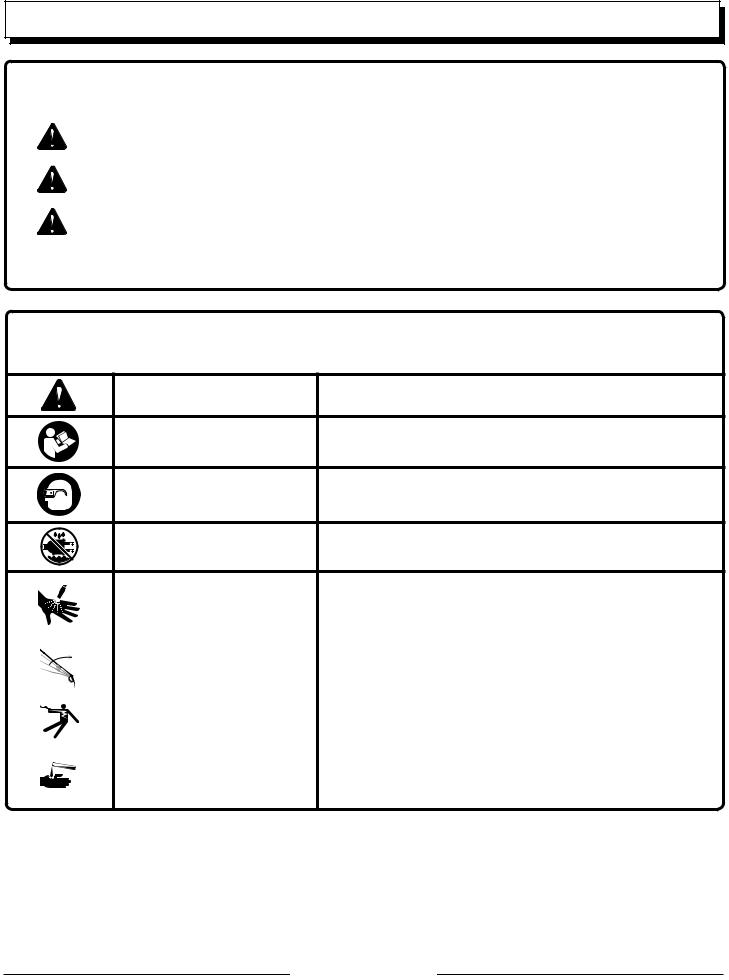
SYMBOLS
The following signal words and meanings are intended to explain the levels of risk associated with this product.
SYMBOL |
SIGNAL |
MEANING |
|
|
|
|
DANGER: |
Indicates an imminently hazardous situation, which, if not avoided, will result |
|
in death or serious injury. |
|
|
|
|
|
|
|
|
WARNING: |
Indicates a potentially hazardous situation, which, if not avoided, could result |
|
in death or serious injury. |
|
|
|
|
|
|
|
|
CAUTION: |
Indicates a potentially hazardous situation, which, if not avoided, may result in |
|
minor or moderate injury. |
|
|
|
|
|
|
|
|
NOTICE: |
(Without Safety Alert Symbol) Indicates important information not related to an |
|
injury hazard, such as a situation that may result in property damage. |
|
|
|
Some of the following symbols may be used on this product. Please study them and learn their meaning. Proper interpretation of these symbols will allow you to operate the product better and safer.
SYMBOL |
NAME |
DESIGNATION/EXPLANATION |
|
Safety Alert |
Indicates a potential personal injury hazard. |
|
Read Operator’s Manual |
To reduce the risk of injury, user must read and understand |
|
operator’s manual before using this product. |
|
|
|
|
|
Eye Protection |
Always wear eye protection with side shields marked to comply |
|
with ANSI Z87.1. |
|
|
|
|
|
Wet Conditions Alert |
Do not expose to rain or use in damp locations. |
|
|
|
To reduce the risk of injection or injury, never direct a water stream |
|
|
|
|
|
|
Risk of Injection |
towards people or pets or place any body part in the stream. Leak- |
|
|
ing hoses and fittings are also capable of causing injection injury. |
|
|
|
|
|
|
|
|
Do not hold hoses or fittings. |
|
|
|
|
|
|
Kickback |
To reduce the risk of injury from kickback, hold the spray wand |
|
|
||
|
|
securely with both hands when the machine is on. |
|
|
|
|
|
|
|
|
|
|
|
|
|
|
|
Electric Shock |
Failure to use in dry conditions and to observe safe practices can |
|
|
||
|
|
result in electric shock. |
|
|
|
|
|
|
|
|
|
|
|
|
|
|
|
|
To reduce the risk of injury or damage, DO NOT USE ACIDS, |
|
|
|
|
|
|
Chemical Burns |
ALKALINES, BLEACHES, SOLVENTS, FLAMMABLE MATERIAL, |
|
|
|
OR INDUSTRIAL GRADE SOLUTIONS in this product. |
|
|
|
Page 6 — English
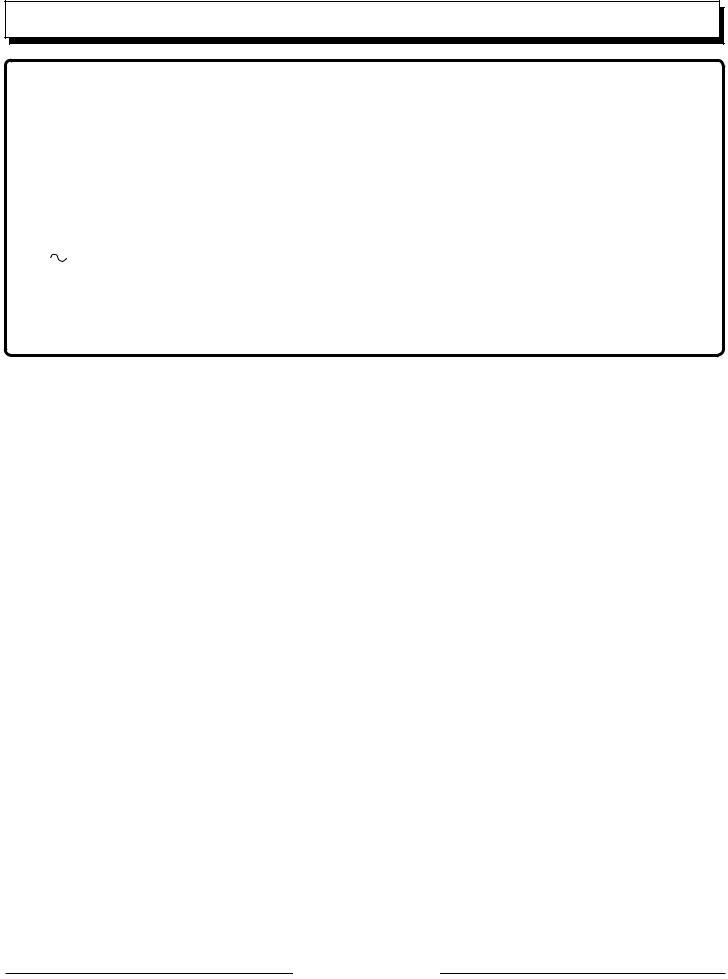
SYMBOLS
Some of the following symbols may be used on this product. Please study them and learn their meaning. Proper interpretation of these symbols will allow you to operate the product better and safer.
SYMBOL |
NAME |
DESIGNATION/EXPLANATION |
|
|
|
V |
Volts |
Voltage |
|
|
|
A |
Amperes |
Current |
|
|
|
Hz |
Hertz |
Frequency (cycles per second) |
|
|
|
W |
Watt |
Power |
|
|
|
|
Alternating Current |
Type of current |
|
|
|
no |
No Load Speed |
Rotational speed, at no load |
.../min |
Per Minute |
Revolutions, strokes, surface speed, orbits etc., per minute |
|
|
|
Page 7 — English
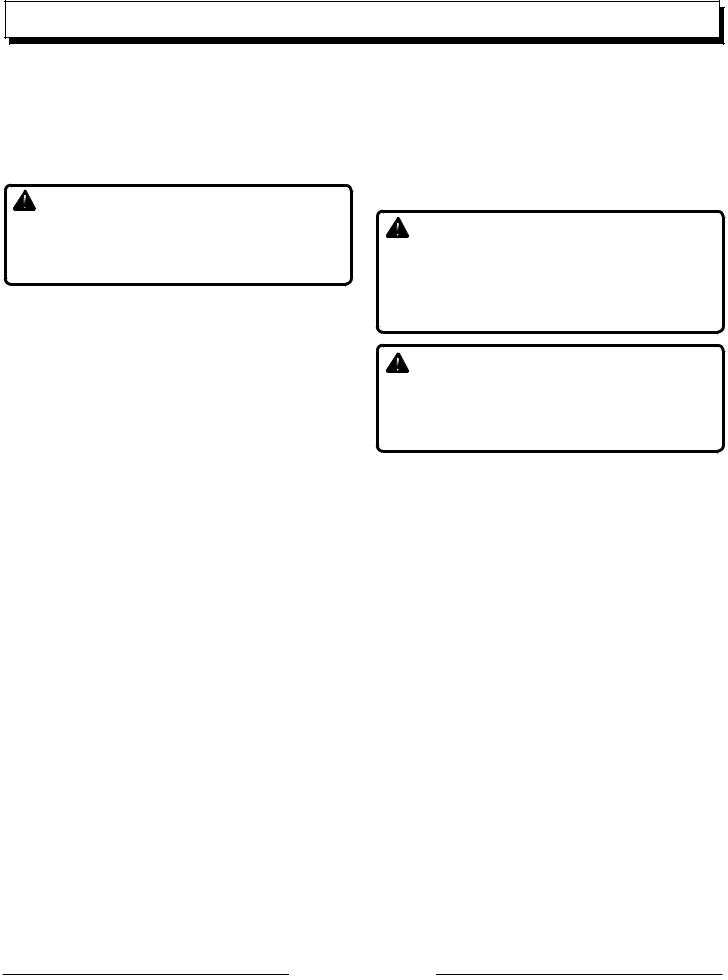
ELECTRICAL
DOUBLE INSULATION
Double insulation is a concept in safety in electric power tools, which eliminates the need for the usual threewire grounded power cord. All exposed metal parts are isolated from the internal metal motor components with protecting insulation. Double insulated products do not need to be grounded.
WARNING:
The double insulated system is intended to protect the user from shock resulting from a break in the product’s internal insulation. Observe all normal safety precautions to avoid electrical shock.
NOTE: Servicing of a product with double insulation requires extreme care and knowledge of the system and should be performed only by a qualified service technician. For service, we suggest you return the product to your nearest authorized service center for repair. Always use original factory replacement parts when servicing.
ELECTRICAL CONNECTION
This product has a precision-built electric motor. It should be connected to a power supply that is 120 volts, AC only (normal household current), 60 Hz. Do not operate this product on direct current (DC). A substantial voltage drop will cause a loss of power and the motor will overheat. If the product does not operate when plugged into an outlet, double-check the power supply.
EXTENSION CORDS
When using a power tool at a considerable distance from a power source, be sure to use an extension cord that has the capacity to handle the current the product will draw. An undersized cord will cause a drop in line voltage, possibly resulting in overheating, loss of power, and/or circuit breaker or GFCI tripping. Use the chart to determine the minimum wire size required in an extension cord. Only round jacketed cords listed by Underwriter’s Laboratories (UL) should be used.
When working outdoors with a product, use an extension cord that is designed for outside use. This type of cord is designated with “WA” or “W” on the cord’s jacket.
Before using any extension cord, inspect it for loose or exposed wires and cut or worn insulation.
It is possible to tie the extension cord and power cord in a knottopreventthemfrombecomingdisconnectedduringuse. Make a knot, then connect the plug end of the power cord into the receptacle end of the extension cord. This method can also be used to tie two extension cords together.
USE ONLY THIS SIZE EXTENSION CORD WHEN USING THIS PRODUCT:
Cord Length |
|
Wire Size (A.W.G.) |
|
|
|
25 ft. |
|
14 |
|
|
|
50 ft. |
|
12 |
|
|
|
100 ft. |
|
Not Allowed |
|
|
|
NOTE: A.W.G. = American Wire Gauge |
|
|
WARNING:
Keep the extension cord clear of the working area. Position the cord so that it will not get caught on lumber, tools, or other obstructions while you are working with a power tool. Failure to do so can result in serious personal injury.
WARNING:
Check extension cords before each use. If damaged replace immediately. Never use the product with a damaged cord since touching the damaged area could cause electrical shock resulting in serious injury.
GROUND FAULT CIRCUIT INTERRUPTER
See Figure 2.
This unit is equipped with a Ground Fault Circuit Interrupter (GFCI), which guards against the hazards of ground fault currents. An example of ground fault current is the current that would flow through a person who is using an appliance with faulty insulation and, at the same time, is in contact with an electrical ground such as a plumbing fixture, wet floor, or earth.
GFCI plugs do not protect against short circuits, overloads, or shocks.
NOTE: To ensure readiness for use, press the reset button each time you connect the pressure washer to the power supply.
The GFCI plug can be tested with the TEST and RESET buttons.
To test:
Press the TEST button. You will hear a “click” sound and the red LED light will go out.
To restore power, press the RESET button. The LED light will illuminate to indicate power has been restored.
Perform this test monthly to ensure proper operation of the GFCI.
To reduce the risk of electric shock the supervisory circuit must be operated before an appliance is plugged into any receptacle on the device.
Page 8 — English
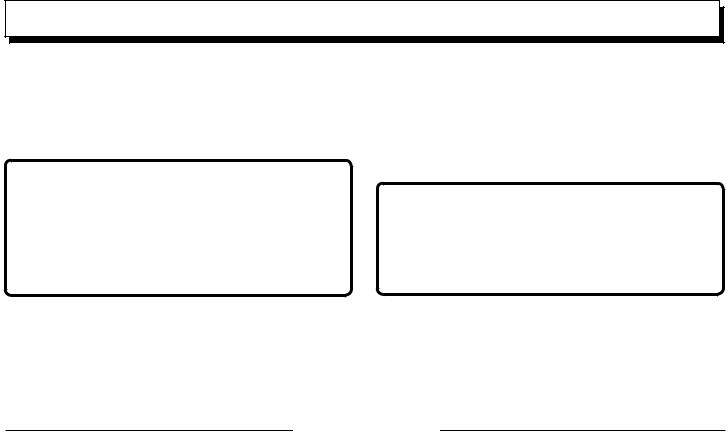
|
|
FEATURES |
|
|
|
|
|
|
|
|
|
|
|
|
|
PRODUCT SPECIFICATIONS |
|
|
|
Induction Motor....................................................................................................................... |
120 V, 60 Hz, 13 Amps, 3-Wire |
||
Maximum Pounds Per Square Inch Pressure*........................................................................................................... |
1700 psi |
||
Maximum Gallons Per Minute*................................................................................................................................... |
1.4 gpm |
||
Maximum Inlet Water Temperature................................................................................................................................. |
104˚F |
||
*Max. rating determined by PWMA Standard 101 |
|
|
|
KNOW YOUR PRESSURE WASHER
See Figure 3.
The safe use of this product requires an understanding of the information on the tool and in this operator’s manual as well as a knowledge of the project you are attempting. Before use of this product, familiarize yourself with all operating features and safety rules.
ON/OFF SWITCH
This switch turns the pressure washer ON and OFF.
POWER CORD STORAGE REEL
Store the power cord on the convenient storage reel when the pressure washer is not in use. Rotate the reel face counter clockwise and remove for quick release of the cord.
DETERGENT TANK
Remove the cap from the detergent tank to add detergent to the pressure washer.
TELESCOPING HANDLE
The telescoping handle allows the handle to be lowered for convenient storage.
GFCI PLUG
The pressure washer is equipped with a GFCI plug to guard against the hazards of ground fault currents. This plug does not protect against short circuits, overloads, or shocks.
HIGH PRESSURE HOSE STORAGE REEL
A convenient hose reel stores the high pressure hose when the pressure washer is not in use.
TRIGGER HANDLE
The trigger handle has a gripping surface that provides added control of the spray wand and helps reduce fatigue.
TRIGGER WITH LOCK-OUT
Pulling the trigger releases a stream of water for high pressure cleaning. The lock-out provides protection against unauthorized use.
ASSEMBLY
UNPACKING
This product requires assembly.
nCarefully remove the product and any accessories from the box. Make sure that all items listed in the packing list are included.
 WARNING:
WARNING:
Do not use this product if any parts on the Packing List are already assembled to your product when you unpack it. Parts on this list are not assembled to the product by the manufacturer and require customer installation. Use of a product that may have been improperly assembled could result in serious personal injury.
nInspect the product carefully to make sure no breakage or damage occurred during shipping.
nDo not discard the packing material until you have carefully inspected and satisfactorily operated the product.
nIf any parts are damaged or missing, please call 1-877-617-3501 for assistance.
PACKING LIST
Pressure Washer with 25 ft. High Pressure Hose Trigger Handle
Spray Wand
Nozzles (25°, Soap, Turbo) Operator’s Manual
 WARNING:
WARNING:
If any parts are damaged or missing do not operate this product until the parts are replaced. Use of this product with damaged or missing parts could result in serious personal injury.
Page 9 — English
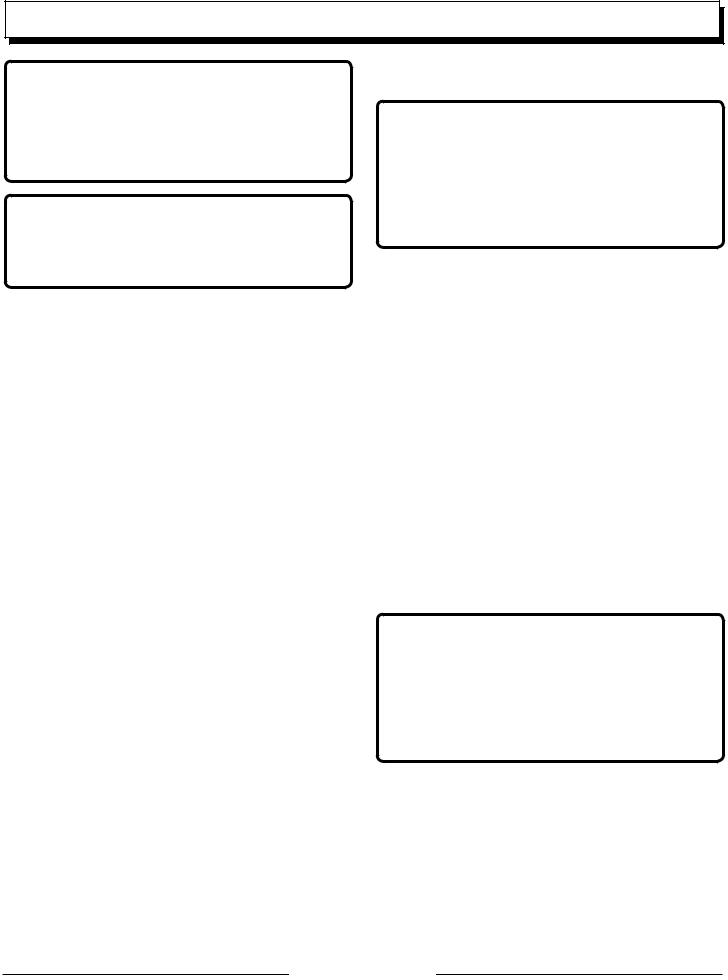
ASSEMBLY
 WARNING:
WARNING:
Do not attempt to modify this product or create accessories not recommended for use with this product. Any such alteration or modification is misuse and could result in a hazardous condition leading to possible serious personal injury.
 WARNING:
WARNING:
Do not connect to power supply until assembly is complete. Failure to comply could result in accidental starting and possible serious personal injury.
ATTACHING THE HANDLE ASSEMBLY
See Figure 4.
n Orient the handle assembly as shown.
nDepress the buttons on the handle assembly and insert into the holes on the pressure washer. Press down on the handle assembly until the buttons on the handle clicks into place.
nTo lower the handle, depress the buttons again and lower the handle completely.
INSTALLING THE SPRAY WAND
See Figure 5.
n Push the end of the spray wand into the trigger handle and rotate clockwise to secure.
nPlace the assembled spray wand in the spray wand holder.
nPull on the spray wand to be certain it is properly secured.
CONNECTING HIGH PRESSURE HOSE TO TRIGGER HANDLE
See Figure 6.
nSlide the hose lock forward to open.
nInsert the high pressure hose into the trigger handle.
NOTE: See Using The High Pressure Hose in Operation for more information about using the high pressure hose.
nSlide the hose lock backward to secure the hose in place.
nPull on the hose to be certain it is properly secured.
CONNECTING THE GARDEN HOSE
See Figure 7.
NOTICE:
Always observe all local regulations when connecting hoses to the water main. Some areas have restrictions against connecting directly to public drinking water supply to prevent the feedback of chemicals into the drinking water supply. Direct connection through a receiver tank or backflow preventer is usually permitted.
The water supply must come from a water main. NEVER use hot water or water from pools, lakes, etc. Before connecting the garden hose to the pressure washer:
nRun water through the hose for 30 seconds to clean any debris from the hose.
nInspect the screen in the water intake.
nIf the screen is damaged, do not use the machine until the screen has been replaced.
nIf the screen is dirty, clean it before connecting the garden hose to the machine.
To connect the garden hose to the machine:
nCompletely uncoil the garden hose or remove completely from reel to prevent kinks.
NOTE: There must be a minimum of 10 feet of unrestricted hose between the pressure washer intake and the hose faucet or shut off valve (such as a “Y” shut off connector).
nWith the hose faucet turned completely off, attach the end of the garden hose to the water intake. Tighten by hand.
NOTICE:
Do not run the pressure washer pump without water supply connected and turned on, as this may damage the high pressure seals and decrease pump life. Completely unwind the hose from its reel or coil and make sure the hose is not being restricted by tires, rocks, or any other objects that may lessen or prevent water flow to the pressure washer.
Page 10 — English
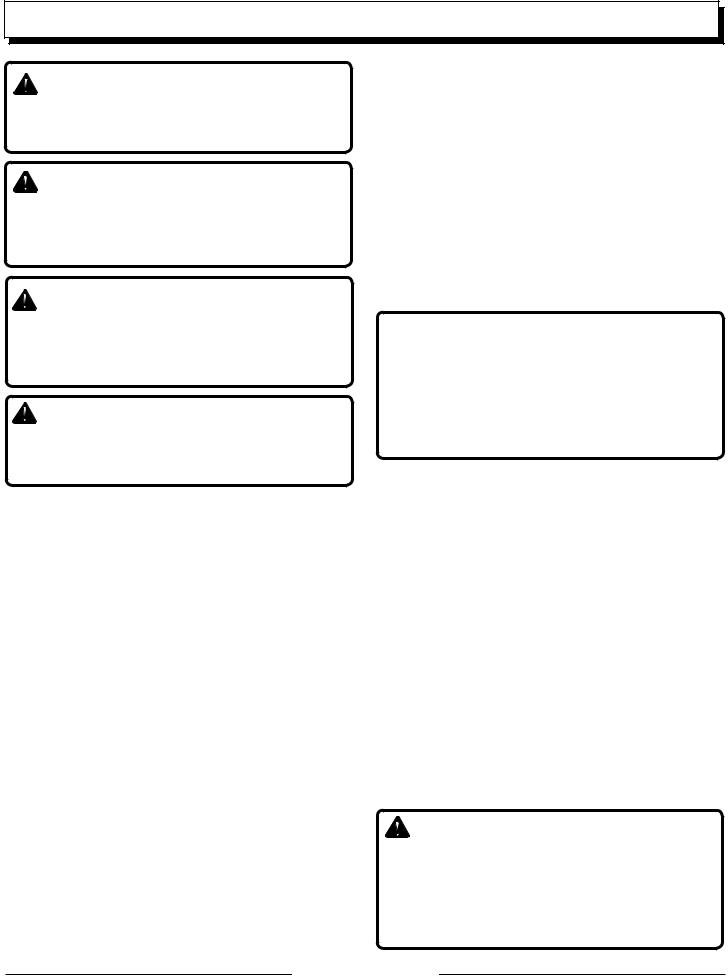
OPERATION
WARNING:
Do not allow familiarity with the product to make you careless. Remember that a careless fraction of a second is sufficient to inflict serious injury.
Pour detergent into tank.
NOTE: Use a funnel, if needed, to prevent accidental spilling of the detergent outside the tank. If any detergent is spilled during the filling process, make sure the unit is cleaned and dried before proceeding.
Reinstall cap.
WARNING:
Always wear eye protection with side shields marked to comply with ANSI Z87.1. Failure to do so could result in objects being thrown into your eyes resulting in possible serious injury.
WARNING:
Do not use any attachments or accessories not recommended by the manufacturer of this product. The use of attachments or accessories not recommended can result in serious personal injury.
WARNING:
Never direct a water stream toward people or pets, or any electrical device. Failure to heed this warning could result in serious injury.
APPLICATIONS
You may use this tool around the house for cleaning most small to large horizontal or vertical exterior surfaces, smaller exterior objects and structures, and outdoor equipment and tools.* You can:
Clean or remove mold and mildew from weathered decks, driveways, patios, walkways, sidewalks, etc.
Remove dirt from various exterior vertical surfaces such as house exteriors, siding, fences, brick, concrete or stone walls, etc.
Wash boats, outdoor furniture, powered or non-powered garden equipment, gutters, window screens, grills, playground equipment, etc.
*Always test in an inconspicuous area first.
ADDING DETERGENT TO THE PRESSURE WASHER
See Figure 8.
Use only detergents designed for pressure washers; household detergents, acids, alkalines, bleaches, solvents, flammable material, or industrial grade solutions can damage the pump. Many detergents may require mixing prior to use. Prepare cleaning solution as instructed on the solution bottle. Always test in an inconspicuous area before beginning.
Disconnect pressure washer from power supply.
Place pressure washer upright on a flat surface.
Remove cap from detergent tank.
PUMP LUBRICANT
The pressure washer pump has been filled with sufficient lubricant at the factory and is maintenance free. You do not need to check or add lubricant to the pump before initial use.
STARTING AND STOPPING THE PRESSURE WASHER
See Figure 9.
NOTICE:
Do not run the pressure washer pump without water supply connected and turned on, as this may damage the high pressure seals and decrease pump life. Completely unwind the hose from its reel or coil and make sure the hose is not being restricted by tires, rocks, or any other objects that may lessen or prevent water flow to the pressure washer.
Connect the garden hose.
Turn the garden hose on then squeeze the trigger to relieve air pressure. Once a steady stream of water appears, release the trigger.
NOTE: Make sure the faucet is turned on fully and that there are no kinks or leaks in the hose.
After ensuring the On/Off switch is in the OFF ( O ) position, connect the pressure washer to the power supply.
NOTE: If using an extension cord, make sure to arrange a drip loop as described on page 3.
Press the reset button on the pressure washer’s plug to make sure the unit is ready for operation.
Press ON ( I ) on the switch to start the motor.
To stop the motor, release the trigger and press OFF ( O ) on the switch.
NOTE: The pressure washer may be on and the sytem may have pressure even when the pump and/or motor cannot be heard running. Always use caution around the pressure washer.
WARNING:
While operating and storing, keep at least 3 feet of clearance on all sides of this product, including overhead. Allow a minimum of 30 minutes of “cool down” time before storage. Heat created by muffler and exhaust gases could be hot enough to cause serious burns and/ or ignite combustible objects.
Page 11 — English
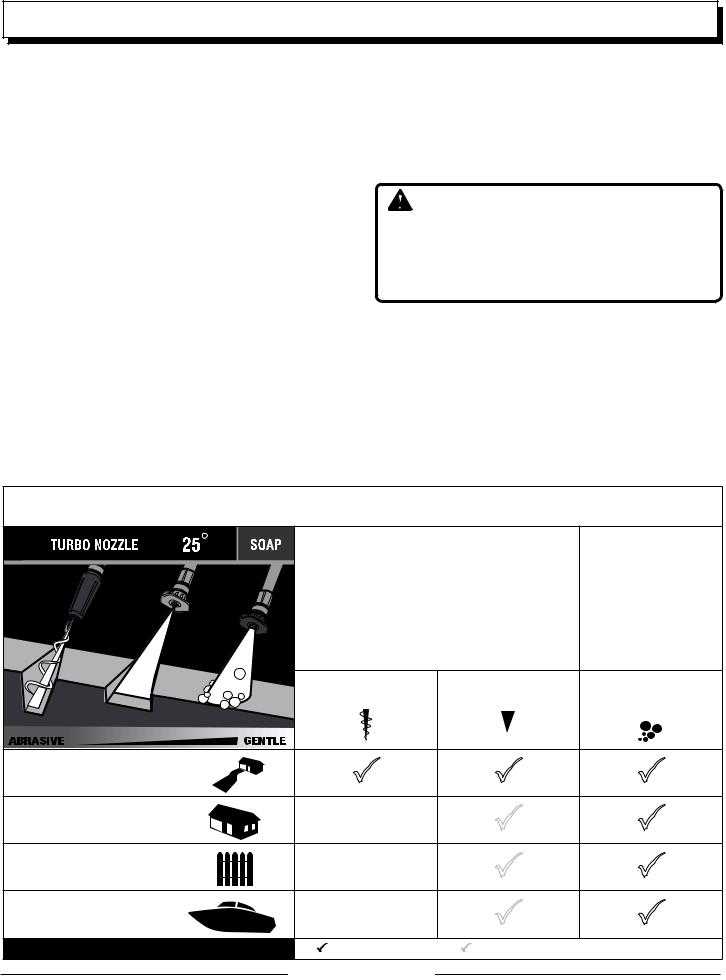
OPERATION
USING THE TRIGGER AND LOCK-OUT
See Figure 10.
For greater control and safety, keep both hands on the trigger handle at all times.
Pull back and hold the trigger to operate the pressure washer.
Release the trigger to stop the flow of water through the nozzle.
To engage the lock-out:
Slide the lock-out button to the left side of the trigger handle to engage the lock-out.
To disengage the lock-out:
Slide the lock-out button to the right side of the trigger handle to disengage the lock-out.
To use the spray wand, start with the nozzle 1-2 ft. away from the cleaning surface. Carefully approach the surface just until the desired level of cleaning is achieved. If the spray is too close it can damage the cleaning surface.
SELECTING THE RIGHT NOZZLE FOR THE JOB
See Figure 11.
Each of the nozzles has a different spray pattern. Before starting any cleaning job, determine the best nozzle for the job. Refer to the Nozzle Selection Guide for more information about which nozzle to choose.
WARNING:
NEVER change nozzles without engaging the lock-out on the trigger handle and NEVER point the wand at your face or at others. The quick-connect feature contains small springs that could eject the nozzle with some force. Failure to heed this may cause personal injury.
To connect a nozzle to the trigger handle:
nTurn off the pressure washer and shut off the water supply. Pull trigger to release water pressure.
nEngage the lock-out on the trigger handle by pushing the trigger lock button to the left.
nPull back the quick-connect collar.
nPush the nozzle into place in the spray wand.
nPush the collar forward so that the nozzle is secured properly. Check to see that the nozzle is secure.
NOZZLE SELECTION GUIDE
|
HIGH PRESSURE |
LOW PRESSURE |
|
|
(FOR SOAP OR |
||
|
(NO SOAP WHEN USING THESE NOZZLES) |
||
|
GENTLE RINSE) |
||
|
|
|
|
|
Turbo Nozzle |
25º |
Blue or Black |
|
Soap Nozzle |
||
|
|
|
|
Concrete, Brick, Masonry |
|
|
|
|
|||
Siding, Gutters, House |
|
|
|
|
|
||
Fencing, Deck, Patio |
|
|
|
|
|
||
Lawn Equipment, Boat, RV |
|
|
|
|
|
||
Recommended Nozzle Use With Caution for Certain Applications
Page 12 — English

OPERATION
To disconnect a nozzle from the trigger handle once the cleaning job is complete:
nTurn off the pressure washer and shut off the water supply. Pull trigger to release water pressure.
nEngage the lock-out on the trigger handle by pushing the trigger lock button to the right.
nRemove the nozzle by placing hand over nozzle then pulling back the quick-connect collar. Place nozzle in the nozzle storage area on the trigger handle.
USING THE HIGH PRESSURE HOSE
The high pressure hose features an outer covering that provides strength to the hose. If the outer covering becomes damaged, the hose must be replaced immediately. Do not use a high pressure hose if the outer covering is damaged.
To prevent damage to the outer covering:
nInspect the hose before every use.
nFully unwrap and straighten hose before use.
nDo not allow the high pressure hose to be kinked.
nKeep hose away from hot surfaces and sharp edges.
nDo not pull unit by high pressure hose.
nDo not allow hose to be crushed or wrapped around objects.
OPERATING THE PRESSURE WASHER
See Figure 12.
Use only detergents designed for pressure washers. Many detergents may require mixing prior to use. Prepare cleaning solution as instructed on the solution bottle.
To clean:
nPour detergent in the detergent tank.
nInstall the blue or black soap nozzle on the spray wand.
nStart the pressure washer and spray the detergent on a dry surface using long, even, overlapping strokes. To prevent streaking, do not allow detergent to dry on the surface.
To rinse:
nUsing the 25˚ nozzle, spray away from the rinsing surface for approximately 10 seconds to allow any remaining detergent to be flushed from the line.
nStart at the top of the area to be rinsed and work down, overlapping the strokes.
MOVING THE PRESSURE WASHER
nTurn the pressure washer off. Point nozzle in a safe direction and pull trigger to release water pressure.
nRaise the handle up until the buttons click into the holes on the handle.
nTilt the machine toward you until it balances on the wheels then roll the machine to the desired position.
nDO NOT attempt to move the unit by pulling on any of the hoses.
Page 13 — English
